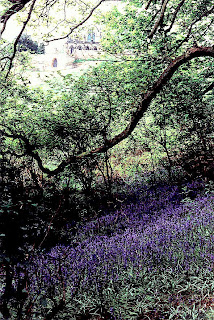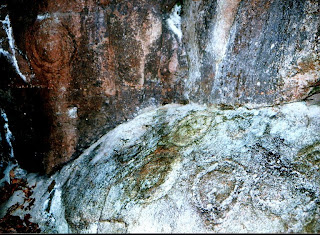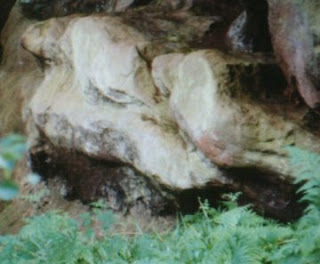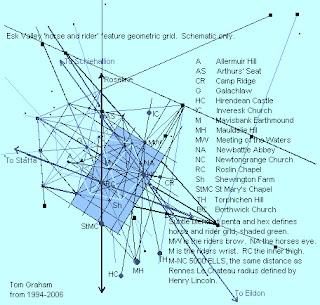
There is a major alignment which all researchers find with ease, in the Lothian area. It runs a few degrees from west of north and includes the summit of Arthurs' Seat Roslin Chapel, St. Mary's Chapel at Mount Lothian, and the summit of Dundreich, a hill at the western end of the Moorfoot Ridge/escarpment. It extends both to the north and south. The area between Arthurs' Seat and Dundreich is the area I lived in during my childhood and a good part of my youth and adult life. It is the area which contains the Esk River system, and a lot of the geometry already described. When I began this investigation I was frustrated that at Roslin Chapel, Arthurs' Seat could not be seen. It was in 1997 when the canopy was installed over the Chapel, that allowed me to confirm by eyesight and photos that the map did not lie, as both Arthurs' Seat and Dundreich are to be seen in dead straight lines looking along the handrail of the gantry, north and south, at the east end of the Chapel.

This is the view along the handrail to Arthurs'Seat, looking north, seen faintly in this photo.
 Dundreich to the south, looking across Roslin Castle, hidden in the trees below. (I'm having a bit of difficulty getting the images neat on the page, but that's ok for now!)
Dundreich to the south, looking across Roslin Castle, hidden in the trees below. (I'm having a bit of difficulty getting the images neat on the page, but that's ok for now!)St.Mary's Chapel is a ruin in this clump of trees, between Roslin and Dundreich, and a major geometric point. A great deal of interest has focussed on this site over the years I have been active.
This line extends both north and south and for now I shall conclude with a graphic from an American friend, William S Buehler, whose work has taken mine to greater lengths and depths over the past seven years than I ever contemplated possible. That his and my geometry kind of fused together as it has done continues to astonish me. That is a long story, I still have difficulty telling. A lot more to do on that whole issue. This graphic shows the system Bill developed based on the Roseline, or Tavhara line in his terminology:
Roslin/Rosslyn Chapel
The Chapel is situated on the flat ground at the top of the valley slope, above the castle. I am concerned here with its setting in the landscape, and this is again a very short introduction and this shall be developed as time goes on. The photos below are all pre. 1997, when the canopy was installed in an effort to dry out the stone of the chapel. These are old photos and not very good quality and are scanned from worn prints.
This is a view from the opposite side of the glen, from the south-east, on the Rosewell road, on a fine summers day, through a gap in the trees.
This is a view of the east side showing the window with the engrailled cross of the Sinclair's, and some of the pyramidian pinnacles.
In May the bluebells down the glen cover large parts either side of the path. The east wall of the chapel can be seen through the trees, quite faint. Not a very good photo, but I am fond of the view from this spot.

This is from a print given to me by an American friend, Ward Ginn. It would appear that there is no glass in the windows at the time of drawing:

Roslin Glen part one
There is a rock on the path down the glen, known as 'lovers leap' which is covered in graffiti, and is a convenient spot to pause, and enjoy the view upstream towards the castle.
some friends resting and gazing upstream.
This little head is reckoned by some to be ancient, and there are marks to the right of it reckoned to Ogham script. The head shown previously is some hundred metres down stream, and may be some indication or way-marker for it. It has lately been identified as a power point of some potency by an American friend who has been working on earth-grids for over thirty years now, William S. Buehler, and I shall be mentioning him often when the story develops.
This black and white was taken in December 1994, when attempting to gain an image of the face described previously. It matched my mood then as I was starting out on this investigation, dark, sombre, lifeless. It was a life-changing period. The ruined castle can be seen at the top.
Same approximate view from the rock upstream, a few years later in spring, and life and colour returning.
Roslin Glen - spirals and rings

Mark Oxbrow, co-author of a recent well received book, Rosslyn & the Grail, showed me this spot a few years back, circa 1999. There are many concentric spirals and ring features covering the walls of the shallow cave/recess. See images below:



Roslin Glen part three - Wallaces Cave
On the opposite bank from the chapel, there is a cave, called
Wallace's Cave, obviously man made, with an 'L' shaped door as seen in this photo. I have been inside only once and from memory it has three round chambers. Unfortunately I didn't have my camera with me that day, and I have not managed to get back to it. At that time there was a fallen beech tree which allowed access to the other bank. It could still be accessed via Gorton House, but I don't know what the owners or occupants think of folks just tramping through. The onus would be on those wishing to visit to check first.
Roslin Glen part four - Castle
A copy of a print given to me by an American friend, Ward Ginn. What the castle is thought to have looked like in its heyday.
Down from the Chapel is Roslin Castle. In a mostly ruinous state after the bombardment by General Monck and his troops, in the mid 17th century. A road leads down to the castle, which ends in a right angled bend at the bridge into the castle. This is formed by an arch across a gap, which seems to have been worked somewhat from the bedrock, as can be seen in these views, with sharp clear angles, especially on the castle side of the arch.
Roslin Glen part five - Hawthornden
Hawthornden Castle is a writers retreat, one time home of Henry Drummond. I seem to have mis-layed my photos of the castle itself so here are some from The Gazetteer of Scotland
These two photos were taken when I took a walk from further downstream, back in 1994, one is of a queer set of steps, the only thing on the other side is a fifty foot(+/-) drop to the river. The other is of 'Hanging Rock' marked on the OS map, 1:25,000.
Roslin Glen part six - The Green Man!?

In 1994 after reading The Temple And The Lodge, I decided to look for the enigmatic face carved in a 'cave' gazing out on passers-by in Roslin Glen, mentioned by the authors Baigent and Leigh.
This was just prior to starting the search for geometry in the Lothian landscape, after finding The Holy Place by Henry Lincoln in Waterstones in Princes Street in Edinburgh one day I went out for a pair of trousers, and came home with 3 books instead. (The other two were Noam Chomsky's 'The 500 Year Conquest Continues', and a book called 'The History Of The Future', concerning R. Sheldrakes theories of morphological resonance, but don't hold me to that, both have gone west a while back.)
Anyway, a group of us cycled to Roslin and spent a few hours down the glen. I ended up making my way down the river bank, slowly, whilst the others kept to the path. I got a shout to come look as they had found it a bit further down.


It was on the other side of the river, some 100 yards downstream from the rock known as 'lovers leap', a flat rock some 50 feet directly above a bend in the river, with names and initials carved over the whole surface. The ruined castle can be seen directly upstream, and the first photos I took were in black and white, on my next few visits whilst attempting to get an image of the 'face'. This took a couple of tries , as I was using too slow a film and the camera was mal-functioning a bit, and I was out of practice.

I eventually got a colour image the one included here.
The river is not always crossable, and care needs to be taken at all times, the bedrock is slippery even at low water when the stream is contained in a channel some 4/5 feet in width which has to be jumped. A small leap of faith for most, but any slip could be disastrous. Extreme caution is advised, at all times.
Once across it is possible to climb up to the feature, which has a pool where a stream splashes onto the beard of the 'face' before settling into the pool at the base. The moss/algae on the face changes colour and shape over the seasons and I came to consider this as The Green Man, larger and more 'alive' than the many representations within the chapel.
To the right is a dry spot, sandstone overhung by rock, with a ledge which later I was to notice comprised a reclining figure with long hair and a beard covered in drapes, perhaps intended to be the figure of the person depicted in the cave.

This second feature was only perceived when on another visit with some other friends, a few years later. I checked back on my photos and it was there all the time. It was a perception thing, I just didn't see it previously.
Two of the reclining figure:


Roslin Glen part seven - end of tour for now!
Just to complete this wee tour of Roslin Glen, two photos I like, one of the bluebells in May and one from the Castle Bridge in autumn:
From the castle bridge, looking downstream, that is north-east, early autumn sunshine.

